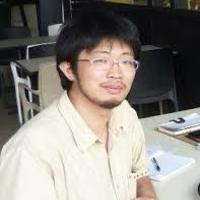Shuichiro Nakao
Osaka University, Graduate School of Language and Culture, Faculty Member
- Arabic, Pidgins and Creoles, Juba Arabic, History of Linguistics, Languages and Linguistics, Historical Linguistics, and 46 moreHistory, Discourse Analysis, Indigenous Studies, Philology, Philosophy of Linguistics, Sociolinguistics, Pragmatics, Semantics, Syntax, Arabic Language and Linguistics, Bilingualism, Code Switching, Arabic Dialects, Arabic Dialectology, Information structure (Languages And Linguistics), Focus and Topic, Arabic Sociolinguistics, Arabic Language, Sudan, Pidgins & Creoles, Afro-Asiatic Linguistics, African Linguistics, Africa Nilo-Saharan Linguistics, Sudanese studies, South Sudan, Nilotic Southern Sudan, Nilotic Languages, Egyptian Arabic, Sabaic inscriptions, Multilingualism, Multiculturalism, Phonology, African Studies, African History, African Diaspora Studies, African languages, African Languages and linguistics, Descriptive Grammar, Synchronic Linguistics (Or Descriptive Linguistics), Descriptive Linguistics, Language Documentation, Indigenous Languages, Sociolinguistics, Field Linguistics, Descriptive Linguistics, Creole languages and education, Pidgin and Creole Languages, Creolization, Variationist Linguistics, and Middle Eastern Studiesedit
- Born in Osaka, graduated from Osaka University (School of Foreign Studies) and Kyoto University (Graduate School of Letters), teaching at Osaka University.edit
Pre-diasporic Arabic (PDA) consonants *ṭ and *q (and/or *ġ) are reflexed as ejective, implosive, or preglottalized consonants in contact situations around South Arabia, the Caucasus, and Africa, in contexts such as Arabic loanwords,... more
Pre-diasporic Arabic (PDA) consonants *ṭ and *q (and/or *ġ) are reflexed as ejective, implosive, or preglottalized consonants in contact situations around South Arabia, the Caucasus, and Africa, in contexts such as Arabic loanwords, traditional pronunciation of Arabic among non-Arabic speakers, Arabic transcribed in non-Arabic alphabets, Arabic (or 'aǧamī) scripts for writing non-Arabic languages, and vernacular and vehicular Arabic varieties. A possible explanation to this phenomenon is to reconstruct PDA *ṭ and *q as unaspirated stops and presume the feature shift [unaspirated] > [glottalic] via substrate influence, but this cannot explain all such instances. Drawing especially on peripheral Egyptian-Sudanic Arabic varieties and Arabic loanwords in Lezgian and Fula, this study concludes that it would be plausible to reconstruct PDA *ṭ and *q as [+constricted glottis] stops phonetically similar to Proto-Semitic *ṭ and *ḳ.
Research Interests:
Research Interests:
Research Interests:
Research Interests:
Research Interests:
Research Interests:
Benishangul Arabic is a hitherto less known variety of Sudanese Arabic spoken by Berta/Funj (Mayu dialect; Nilo-Saharan) speakers in Benishangul-Gumuz Region, western Ethiopia (Nakao 2017). This study aims at presenting two text s in... more
Benishangul Arabic is a hitherto less known variety of Sudanese Arabic spoken by Berta/Funj (Mayu dialect; Nilo-Saharan) speakers in Benishangul-Gumuz Region, western Ethiopia (Nakao 2017). This study aims at presenting two text s in Benishangul Arabic collected during the author 's fieldwork at Asossa in September 2017 and March 2019. In addition to descriptive linguistic transcription, glossing and translation, this study provides the edited texts in the Arabic script (more etymological, less phonemic) and the Berta orthography based on the Latin script (less etymological, more phonemic) for potential use as educational materials.
Research Interests:
Research Interests:
Research Interests:
Research Interests:
Research Interests:
Research Interests:
Research Interests:
Benishangul Arabic (abbreviated BSA) is a newly-discovered contact variety of Sudanese Arabic spoken as a hereditary second language of local Muslim populations (mainly Berta/Benishangul people) in Benishangul-Gumuz Region in western... more
Benishangul Arabic (abbreviated BSA) is a newly-discovered contact variety of Sudanese Arabic spoken as a hereditary second language of local Muslim populations (mainly Berta/Benishangul people) in Benishangul-Gumuz Region in western Ethiopia. Based on the author's fieldwork at Assosa in 2017, this report aims at providing a basic description of BSA. This first part of this report deals with the basic sociolinguistic situation surrounding BSA (with a focus on the hybrid nature of its substrate language, Mayu dialect of Berta/Benishangul language, Nilo-Saharan) and its phonological and nominal/adjectival morphosyntactic structures. Phonologically, BSA is unique among Arabic varieties in that it has (i) two ejectives /k'/ and /t'/ and (ii) lexically and grammatically distinctive tones (rather than stress), but (iii) no voicing contrast. In the nominal/adjectival morphosyntax,
Research Interests:
Research Interests:
Research Interests:
Research Interests:
Research Interests:
Research Interests:
Research Interests:
A descriptive grammar of Juba Arabic, an Arabic-based creole spoken in South Sudan (and diaspora South Sudanese) as a lingua franca and an urban language. Unpublished.
